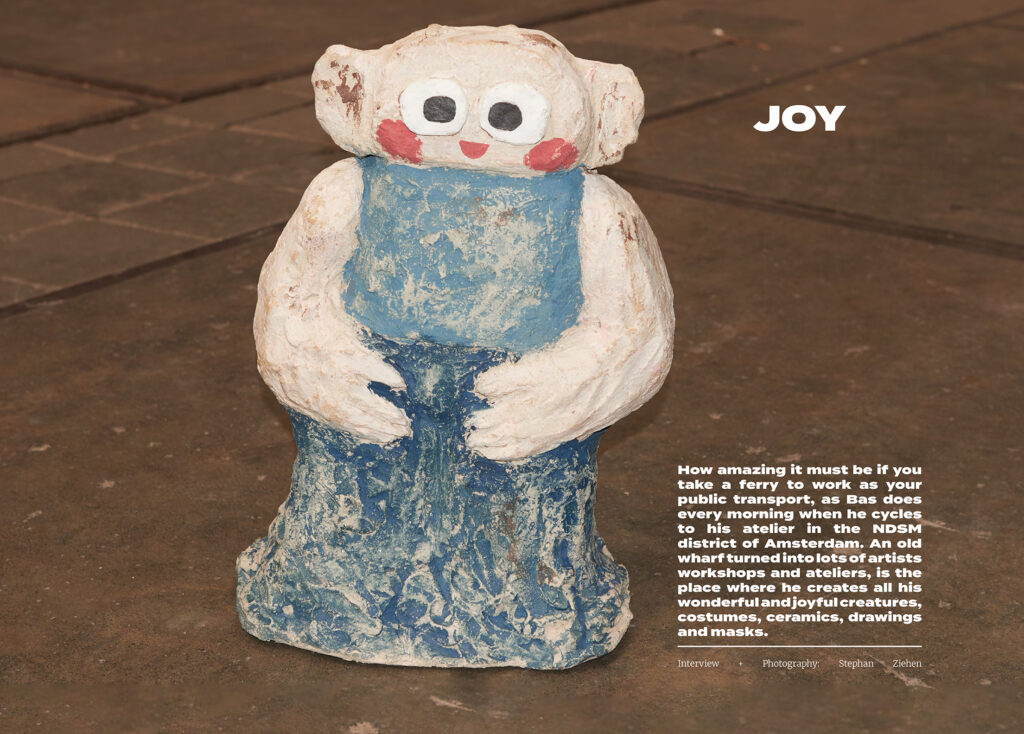
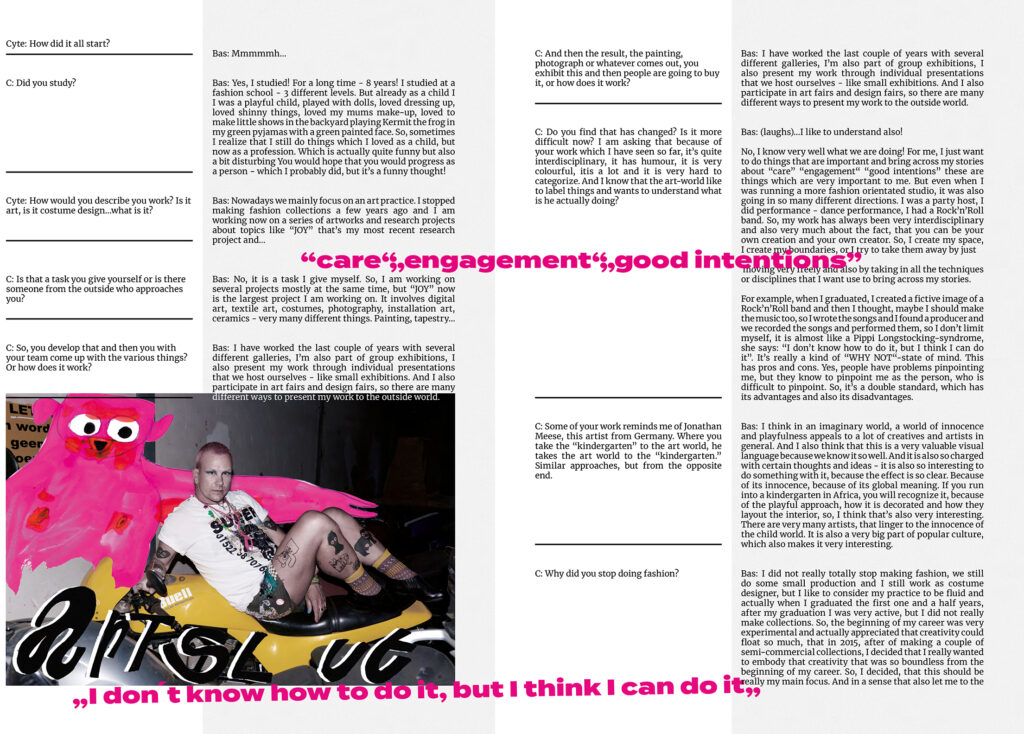
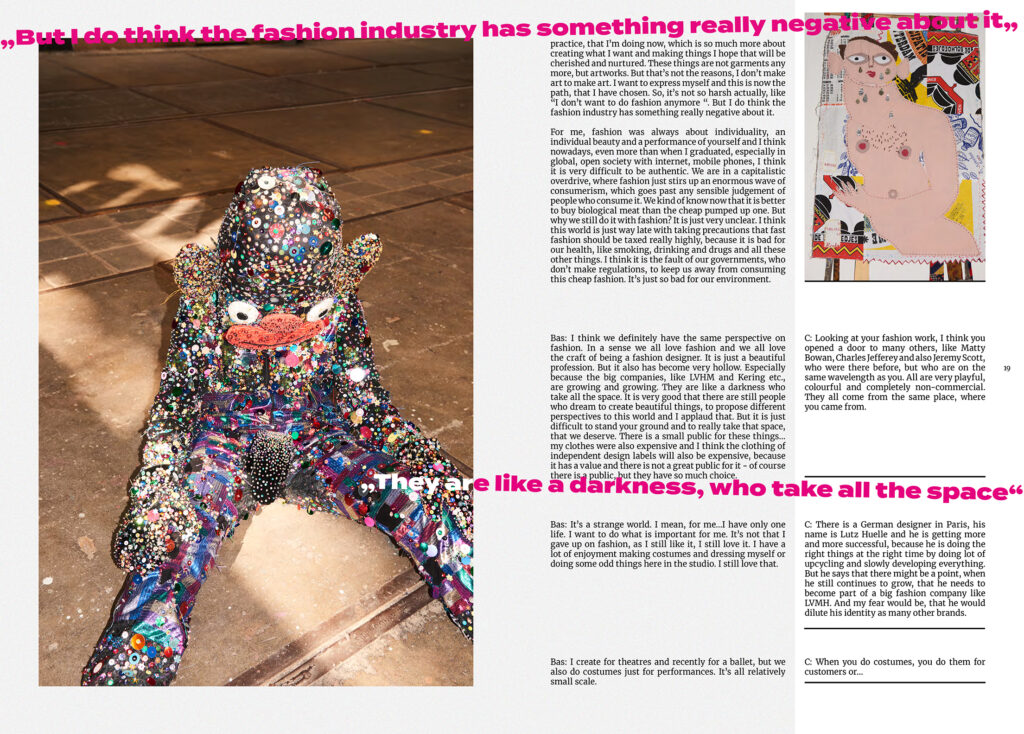
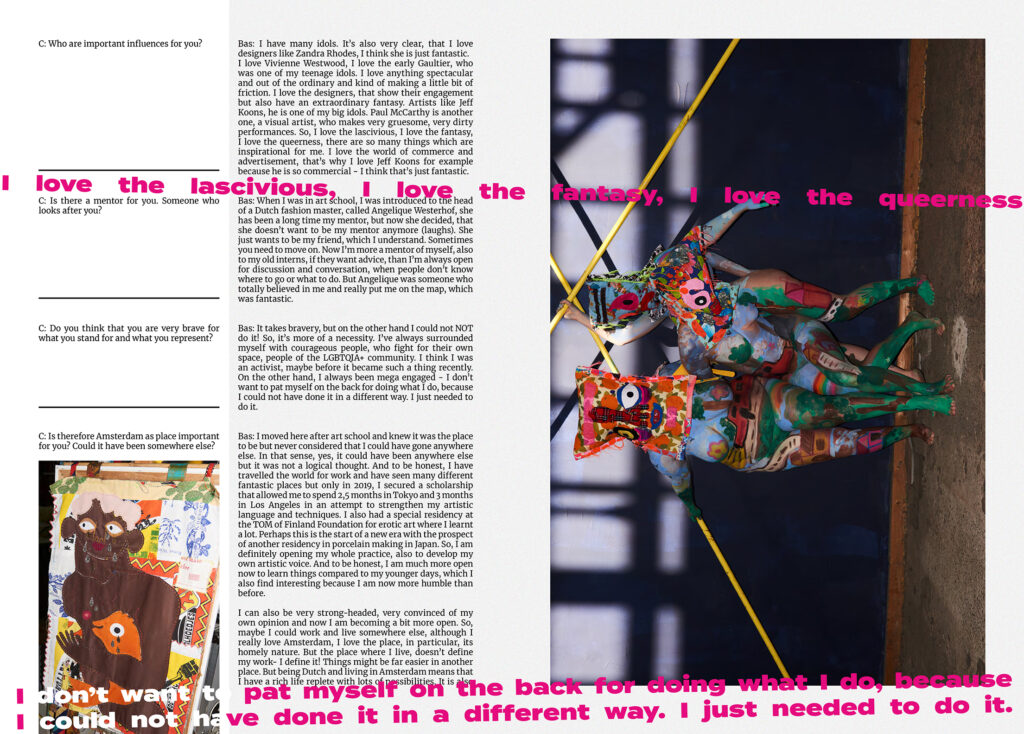
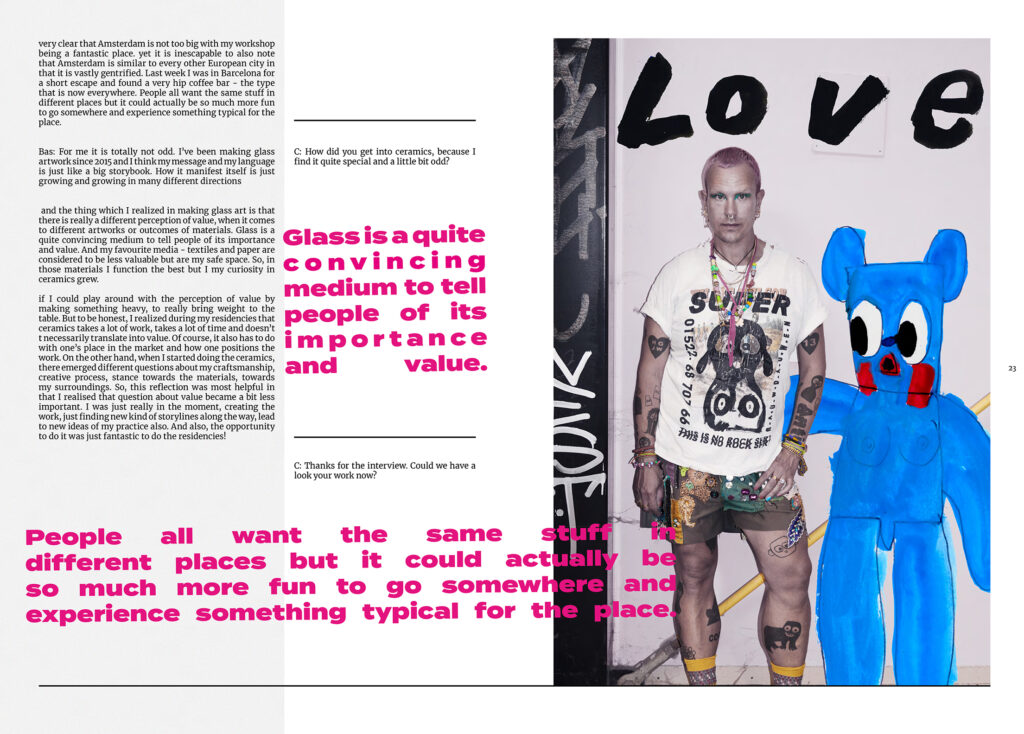
JOY – Bas Kosters
Subtitle: How amazing it must be if you take a ferry to work as your public transport, as Bas does every morning when he cycles to his atelier in the NDSM district of Amsterdam. An old wharf turned into lots of artists workshops and ateliers, is the place where he creates all his wonderful and joyful creatures, costumes, ceramics, drawings and masks.
Cyte: How did it all start?
Bas: Mmmmmh…
C: Did you study?
Bas: Yes, I studied! For a long time – 8 years! I studied at a fashion school – 3 different levels. But already as a child I I was a playful child, played with dolls, loved dressing up, loved shinny things, loved my mums make-up, loved to make little shows in the backyard playing Kermit the frog in my green pyjamas with a green painted face. So, sometimes I realize that I still do things which I loved as a child, but now as a profession. Which is actually quite funny but also a bit disturbing You would hope that you would progress as a person – which I probably did, but it’s a funny thought!
Cyte: How would you describe you work? Is it art, is it costume design…what is it?
Bas: Nowadays we mainly focus on an art practice. I stopped making fashion collections a few years ago and I am working now on a series of artworks and research projects about topics like “JOY” that’s my most recent research project and…
C: Is that a task you give yourself or is there someone from the outside who approaches you?
Bas: No, it is a task I give myself. So, I am working on several projects mostly at the same time, but “JOY” now is the largest project I am working on. It involves digital art, textile art, costumes, photography, installation art, ceramics – very many different things. Painting, tapestry…
C: So, you develop that and then you with your team come up with the various things?
Or how does it work?
Bas: No, I’m always in charge of what happens, so I give the creative direction and then the team follows my sketches, so I sketch and the team executes.
C: And then the result, the painting, photograph or whatever comes out, you exhibit this and then people are going to buy it, or how does it work?
Bas: I have worked the last couple of years with several different galleries, I’m also part of group exhibitions, I also present my work through individual presentations that we host ourselves – like small exhibitions. And I also participate in art fairs and design fairs, so there are many different ways to present my work to the outside world.
C: Do you find that has changed? Is it more difficult now? I am asking that because of your work which I have seen so far, it’s quite interdisciplinary, it has humour, it is very colourful, itis a lot and it is very hard to categorize. And I know that the art-world like to label things and wants to understand what is he actually doing?
Bas: (laughs)…I like to understand also!
No, I know very well what we are doing! For me, I just want to do things that are important and bring across my stories about “care” “engagement“ “good intentions” these are things which are very important to me. But even when I was running a more fashion orientated studio, it was also going in so many different directions. I was a party host, I did performance – dance performance, I had a Rock’n’Roll band. So, my work has always been very interdisciplinary and also very much about the fact, that you can be your own creation and your own creator. So, I create my space, I create my boundaries, or I try to take them away by just moving very freely and also by taking in all the techniques or disciplines that I want use to bring across my stories.
For example, when I graduated, I created a fictive image of a Rock’n’Roll band and then I thought, maybe I should make the music too, so I wrote the songs and I found a producer and we recorded the songs and performed them, so I don’t limit myself, it is almost like a Pippi Longstocking-syndrome, she says: “I don’t know how to do it, but I think I can do it”. It’s really a kind of “WHY NOT“-state of mind. This has pros and cons. Yes, people have problems pinpointing me, but they know to pinpoint me as the person, who is difficult to pinpoint. So, it’s a double standard, which has its advantages and also its disadvantages.
C: Some of your work reminds me of Jonathan Meese, this artist from Germany. Where you take the “kindergarten” to the art world, he takes the art world to the “kindergarten.” Similar approaches, but from the opposite end.
Bas: I think in an imaginary world, a world of innocence and playfulness appeals to a lot of creatives and artists in general. And I also think that this is a very valuable visual language because we know it so well. And it is also so charged with certain thoughts and ideas – it is also so interesting to do something with it, because the effect is so clear. Because of its innocence, because of its global meaning. If you run into a kindergarten in Africa, you will recognize it, because of the playful approach, how it is decorated and how they layout the interior, so, I think that’s also very interesting. There are very many artists, that linger to the innocence of the child world. It is also a very big part of popular culture, which also makes it very interesting.
C: Why did you stop doing fashion?
Bas: I did not really totally stop making fashion, we still do some small production and I still work as costume designer, but I like to consider my practice to be fluid and actually when I graduated the first one and a half years, after my graduation I was very active, but I did not really make collections. So, the beginning of my career was very experimental and actually appreciated that creativity could float so much, that in 2015, after of making a couple of semi-commercial collections, I decided that I really wanted to embody that creativity that was so boundless from the beginning of my career. So, I decided, that this should be really my main focus. And in a sense that also let me to the practice, that I’m doing now, which is so much more about creating what I want and making things I hope that will be cherished and nurtured. These things are not garments any more, but artworks. But that’s not the reasons, I don’t make art to make art. I want to express myself and this is now the path, that I have chosen. So, it’s not so harsh actually, like “I don’t want to do fashion anymore “. But I do think the fashion industry has something really negative about it.
For me, fashion was always about individuality, an individual beauty and a performance of yourself and I think nowadays, even more than when I graduated, especially in global, open society with internet, mobile phones, I think it is very difficult to be authentic. We are in a capitalistic overdrive, where fashion just stirs up an enormous wave of consumerism, which goes past any sensible judgement of people who consume it. We kind of know now that it is better to buy biological meat than the cheap pumped up one. But why we still do it with fashion? It is just very unclear. I think this world is just way late with taking precautions that fast fashion should be taxed really highly, because it is bad for our health, like smoking, drinking and drugs and all these other things. I think it is the fault of our governments, who don’t make regulations, to keep us away from consuming this cheap fashion. It’s just so bad for our environment.
C: Looking at your fashion work, I think you opened a door to many others, like Matty Bowan, Charles Jefferey and also Jeremy Scott, who were there before, but who are on the same wavelength as you. All are very playful, colourful and completely non-commercial. They all come from the same place, where you came from.
Bas: I think we definitely have the same perspective on fashion. In a sense we all love fashion and we all love the craft of being a fashion designer. It is just a beautiful profession. But it also has become very hollow. Especially because the big companies, like LVHM and Kering etc., are growing and growing. They are like a darkness who take all the space. It is very good that there are still people who dream to create beautiful things, to propose different perspectives to this world and I applaud that. But it is just difficult to stand your ground and to really take that space, that we deserve. There is a small public for these things…my clothes were also expensive and I think the clothing of independent design labels will also be expensive, because it has a value and there is not a great public for it – of course there is a public, but they have so much choice.
C: There is a German designer in Paris, his name is Lutz Huelle and he is getting more and more successful, because he is doing the right things at the right time by doing lot of upcycling and slowly developing everything. But he says that there might be a point, when he still continues to grow, that he needs to become part of a big fashion company like LVMH. And my fear would be, that he would dilute his identity as many other brands.
Bas: It’s a strange world. I mean, for me…I have only one life. I want to do what is important for me. It’s not that I gave up on fashion, as I still like it, I still love it. I have a lot of enjoyment making costumes and dressing myself or doing some odd things here in the studio. I still love that.
C: When you do costumes, you do them for customers or…
Bas: I create for theatres and recently for a ballet, but we also do costumes just for performances. It’s all relatively small scale.
C: Who are important influences for you?
Bas: I have many idols. It’s also very clear, that I love designers like Zandra Rhodes, I think she is just fantastic. I love Vivienne Westwood, I love the early Gaultier, who was one of my teenage idols. I love anything spectacular and out of the ordinary and kind of making a little bit of friction. I love the designers, that show their engagement but also have an extraordinary fantasy. Artists like Jeff Koons, he is one of my big idols. Paul McCarthy is another one, a visual artist, who makes very gruesome, very dirty performances. So, I love the lascivious, I love the fantasy, I love the queerness, there are so many things which are inspirational for me. I love the world of commerce and advertisement, that’s why I love Jeff Koons for example because he is so commercial – I think that’s just fantastic.
C: Is there a mentor for you. Someone who looks after you?
Bas: When I was in art school, I was introduced to the head of a Dutch fashion master, called Angelique Westerhof, she has been a long time my mentor, but now she decided, that she doesn’t want to be my mentor anymore (laughs). She just wants to be my friend, which I understand. Sometimes you need to move on. Now I’m more a mentor of myself, also to my old interns, if they want advice, than I’m always open for discussion and conversation, when people don’t know where to go or what to do. But Angelique was someone who totally believed in me and really put me on the map, which was fantastic.
C: Do you think that you are very brave for what you stand for and what you represent?
Bas: It takes bravery, but on the other hand I could not NOT do it! So, it’s more of a necessity. I’ve always surrounded myself with courageous people, who fight for their own space, people of the LGBTQIA+ community. I think I was an activist, maybe before it became such a thing recently. On the other hand, I always been mega engaged – I don’t want to pat myself on the back for doing what I do, because I could not have done it in a different way. I just needed to do it.
C: Is therefore Amsterdam as place important for you? Could it have been somewhere else?
Bas: I moved here after art school and knew it was the place to be but never considered that I could have gone anywhere else. In that sense, yes, it could have been anywhere else but it was not a logical thought. And to be honest, I have travelled the world for work and have seen many different fantastic places but only in 2019, I secured a scholarship that allowed me to spend 2,5 months in Tokyo and 3 months in Los Angeles in an attempt to strengthen my artistic language and techniques. I also had a special residency at the TOM of Finland Foundation for erotic art where I learnt a lot. Perhaps this is the start of a new era with the prospect of another residency in porcelain making in Japan. So, I am definitely opening my whole practice, also to develop my own artistic voice. And to be honest, I am much more open now to learn things compared to my younger days, which I also find interesting because I am now more humble than before.
I can also be very strong-headed, very convinced of my own opinion and now I am becoming a bit more open. So, maybe I could work and live somewhere else, although I really love Amsterdam, I love the place, in particular, its homely nature. But the place where I live, doesn’t define my work- I define it! Things might be far easier in another place. But being Dutch and living in Amsterdam means that I have a rich life replete with lots of possibilities. It is also very clear that Amsterdam is not too big with my workshop being a fantastic place. yet it is inescapable to also note that Amsterdam is similar to every other European city in that it is vastly gentrified. Last week I was in Barcelona for a short escape and found a very hip coffee bar – the type that is now everywhere. People all want the same stuff in different places but it could actually be so much more fun to go somewhere and experience something typical for the place.
C: How did you get into ceramics, because I find it quite special and a little bit odd?
Bas: For me it is totally not odd. I’ve been making glass artwork since 2015 and I think my message and my language is just like a big storybook. How it manifest itself is just growing and growing in many different directions and the thing which I realized in making glass art is that there is really a different perception of value, when it comes to different artworks or outcomes of materials. Glass is a quite convincing medium to tell people of its importance and value. And my favourite media – textiles and paper are considered to be less valuable but are my safe space. So, in those materials I function the best but I my curiosity in ceramics grew.
if I could play around with the perception of value by making something heavy, to really bring weight to the table. But to be honest, I realized during my residencies that ceramics takes a lot of work, takes a lot of time and doesn’t t necessarily translate into value. Of course, it also has to do with one’s place in the market and how one positions the work. On the other hand, when I started doing the ceramics, there emerged different questions about my craftsmanship, creative process, stance towards the materials, towards my surroundings. So, this reflection was most helpful in that I realised that question about value became a bit less important. I was just really in the moment, creating the work, just finding new kind of storylines along the way, lead to new ideas of my practice also. And also, the opportunity to do it was just fantastic to do the residencies!
C: Thanks for the interview. Could we have a look your work now?